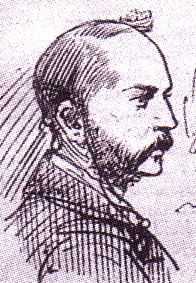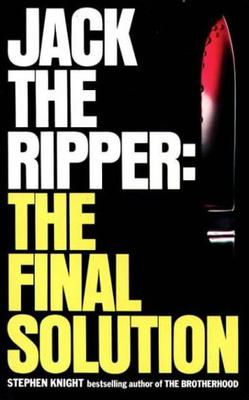
Eddie Campbell is a British comics artist and cartoonist. He was the illustrator and publisher of From Hell, and the creator of the semi-autobiographical Alec stories collected in Alec: The Years Have Pants, and Bacchus, a wry adventure series about the few Greek gods who have survived to the present day.

Sir William Withey Gull, 1st Baronet was an English physician. Of modest family origins, he established a lucrative private practice and served as Governor of Guy's Hospital, Fullerian Professor of Physiology and President of the Clinical Society. In 1871, having successfully treated the Prince of Wales during a life-threatening attack of typhoid fever, he was created a Baronet and appointed to be one of the Physicians-in-Ordinary to Queen Victoria.

Colleen Doran is an American writer-artist and cartoonist. She illustrated hundreds of comics, graphic novels, books and magazines, including the autobiographical graphic novel of Marvel Comics editor and writer Stan Lee entitled Amazing Fantastic Incredible Stan Lee, which became a New York Times bestseller. She adapted and did the art for the short story "Troll Bridge" by Neil Gaiman, which also became a New York Times bestseller. Her books have received Eisner, Harvey, Bram Stoker, Locus, and International Horror Guild Awards.

Murder by Decree is a 1979 mystery thriller film directed by Bob Clark. It features the Sherlock Holmes and Dr. John Watson characters created by Sir Arthur Conan Doyle, who are embroiled in the investigation surrounding the real-life 1888 Whitechapel murders committed by "Jack the Ripper". Christopher Plummer plays Holmes and James Mason plays Watson. Though it features a similar premise, it is somewhat different in tone and result to A Study in Terror. It is loosely based on The Ripper File by Elwyn Jones and John Lloyd.

A series of murders that took place in the East End of London from August to November 1888 was blamed on an unidentified assailant who was nicknamed Jack the Ripper. Since then, the identity of the killer has been widely debated, with over 100 suspects named. Though many theories have been advanced, experts find none widely persuasive, and some are hardly taken seriously at all.

Frederick George Abberline was a British chief inspector for the London Metropolitan Police. He is best known for being a prominent police figure in the investigation into the Jack the Ripper serial killer murders of 1888.

Philip Craig Russell is an American comics artist, writer, and illustrator. His work has won multiple Harvey and Eisner Awards. Russell was the first mainstream comic book creator to come out as openly gay.

Jack the Ripper: The Final Solution is a book written by Stephen Knight first published in 1976. It proposed a solution to five murders in Victorian London that were blamed on an unidentified serial killer known as "Jack the Ripper".

Stephen R. Bissette is an American comic book artist and publisher with a focus on the horror genre. He worked with writer Alan Moore and inker John Totleben on the DC Comics series Swamp Thing in the 1980s.
James H. Williams III, usually credited as J. H. Williams III, is an American comics artist and penciller. He is known for his work on titles such as Chase, Promethea, Desolation Jones,Batwoman, and The Sandman: Overture.
Jack the Ripper, a notorious serial killer who terrorized Whitechapel in 1888, has been featured in works of fiction ranging from gothic novels published at the time of the murders to modern motion pictures, televised dramas and video games.

From Hell is a 2001 period detective horror film directed by the Hughes Brothers and written by Terry Hayes and Rafael Yglesias. It is loosely based on the graphic novel of the same name by Alan Moore and Eddie Campbell about the Jack the Ripper murders. The film stars Johnny Depp as Frederick Abberline, the lead investigator of the murders, and Heather Graham as Mary Kelly, a prostitute targeted by the Ripper. Other cast members include Ian Holm, Robbie Coltrane, Ian Richardson and Jason Flemyng.
James Vance was an American comic book writer, author and playwright, best known for his work from Kitchen Sink Press and in particular the lauded Kings in Disguise.

John Charles Netley was an English cab driver who was later claimed to have been involved in the 'Whitechapel Murders' committed by the unidentified serial killer Jack the Ripper.

Taboo is a comics anthology edited by Steve Bissette that was designed to feature edgier and more adult comics than could be published through mainstream publishers. The series began as a horror anthology, but soon branched out into other genres as well. It was published by various imprints from 1988 to 1995.

Alan Moore is an English author known primarily for his work in comic books including Watchmen, V for Vendetta, The Ballad of Halo Jones, Swamp Thing, Batman: The Killing Joke, and From Hell. He is widely recognised among his peers and critics as one of the best comic book writers in the English language. Moore has occasionally used such pseudonyms as Curt Vile, Jill de Ray, Brilburn Logue, and Translucia Baboon; also, reprints of some of his work have been credited to The Original Writer when Moore requested that his name be removed.

Robert James Lees was a British spiritualist, medium, preacher, writer and healer of the late Victorian era and early twentieth century known today for claims that he knew the identity of Jack the Ripper, responsible for the Whitechapel murders of 1888.

Jack the Ripper is a 1988 Anglo-American co-production by Thames Television and CBS television film drama based on the notorious Jack the Ripper murder spree in Victorian London. It was first broadcast on ITV.
Jeff Nicholson is an American comic book writer, artist and self-publisher, known primarily for his work on Ultra Klutz, Through the Habitrails, Father & Son, and Colonia. Nicholson received a total of six Comics Industry Eisner Award nominations in his 25-year career, and was one of the first four recipients of the Xeric Award comic book self-publishing grants in 1992.

Jack the Ripper's Bedroom is an oil on canvas painting by German-born British artist Walter Sickert, painted from c. 1906 to 1907. It depicts the darkly lit bedroom of Jack the Ripper, the culprit of at least five of London's Whitechapel murders in 1888. A shape in the middle looks like a person, but is not, according to the Manchester Art Gallery, where the painting has mostly stayed since 1980.
















